Basketball exercises for seniors
Requirements:
players must be able to run a lay up from a bounce pass
Goal: learn
how to punish the overplaying of the forward by an aggressive defense
Organization:
- guard dribbles up from behind the centre circle
- at the same moment the centre 4 comes to the elbow
- and player 3 sprints to the pawn
- 1 passes to 4 with a bounce pass
- 3 sprints to the basket with a sharp change of direction and speed
- and receives the bounce pass from 4
Rotation:
- 4 grabs the rebound
- and takes the ball on the back line
- 3 goes to defend the inbound pass
- when 9 receives the ball, 7 takes position at the sideline for the next inbound pass
- 4 and 5 do not rotate but take turns.
- 1 joins the line behind the pawn
- 9 passes the ball to 8 and joins the row behind it
Variation:
- 1 pretends he is going to put a screen away on the weak side, but cuts to 4 for a hand off
- takes the shot
- OR plays pick and roll with 4
Teaching Points:
- Sprint to the pawn: when passing, you as the attacker must take the defender well outside the three-point line to create enough space for the back door.
- 1 must feint immediately after the pass to be in time for the hand-off.
Requirements:
players must be able to drive and shoot from the 3-point line
Objective:
1) improve penetration2
) pass out to the shooter from the bucket3
) players without the ball respond to penetration
Organization:
- penetration ends with jump stop
- pass to the shooter
- immediately find a position outside the three-point line.
- at least 3 penetrations
- score only with shots
- play up to the 5 scores
Teaching points:
- jump stop so you have the choice of pivot foot (but can also shoot directly)
- the two players without the ball are always actively creating blans in the space division
- be playable at a place from where you can shoot or drive directly
- drive with the right hand is to rotate clockwise; counterclockwise with a left dribble
- OR other agreements you have within your team
Requirements:
- players must be able to drive and shoot from the 3-point line
- must know what defending ball side and weak side is
Objective:
1) recognize that the defender is giving maximum pressure on the shot and therefore there is room for the drive2
) see the help coming3
) learn way to play off the help as well
Organization:
- attacker 1 gives a bounce pass to himself on the forward position
- defender 2 is allowed to move when the ball hits the ground
- the attacker pivots so that he can shoot
- free shot (i.e. the ball is not touched by the defender) is a point for the attacker
- dribble stopped and score prevented by defender 2 is one point for the defender
- defender 3 starts with one foot in the bucket and is not allowed to move until the ball touches the ground at the start of the drive
- defender 3 earns one point when he prevents a score by the broken through attacker
- play until the 3
Teaching points:
- attackers when picking up the ball immediately pivot and take triple threat position
- Defender 2 has to start explosively and bridge the last one and a half metres with mini-slides.
- one hand high, in the shooter's field of vision
- the foot on the ball side is behind
- (OR other agreements you have within the team)
Attacker:
- with a crossover step around the help and finish with a power move
- stop with a jump stop after the first dribble and finish with a jump shot, fade away or rocker step
Helper
- estimate on which side the attacker will drive
- quick first step
- attacker may never pass between defender 2 and helper
Prerequisites:
players must be able to individually pivot and drive from the 3-point line
Goal: in-out
movement, pass lines and drive to the basket
Organization:
- first man in line has no ball
- Makes his in-out move and asks for the ball with his outside hand at the 3-point line.
- Pivots and thus brings himself into the dribble start position
- with one bounce to the basket
- Finish with lay up
- Catch it yourself, dribble to the corner of the court on the other side than where you started.
- pass the ball to the man in the back and connect with him.
- Everyone in line moves up 1 position
Teaching points:
- always make a front move while making the front pivot (face the basket)
- Adjust on the outside hand, high
- Sit deep in the spin
- Pass the ball below knee height
- After the turn, feet pointing to the basket
- Knees strongly bent after the turn
- shoulders above the feet
- Ready for shot or drive
Variations:
When players have mastered the footwork, expand to include:
- open step to the elbow + shot
- shot fake + 1 bounce + jump shot side bucket (move parallel to the sideline)
Requirements:
players must be able to drive and shoot from the free throw line
Goal: 1)
see
the
help coming2)
judge if you have time to run a lay up or if you should stop and shoot
Organization:
- attacker 1 dribbles in the indicated direction around the pawn
- defender 2 simulates the helper
- defender 3 simulates the defender who just passed the dribbler
- each player attacks x times
Teaching points:
during the dribble, assess the speed of the helper and make a decision
Variations:
- by moving the helper's pawn further away from the ring, there is more room for a lay up
- Move the pawn closer to the ring to stimulate a stop and a jump shot.
Requirements:
players must be able to drive and shoot from the 3-point line
Goal: get free
at the forward position and improve scoring ability from that position
Organization:
- attacker 1 receives the pass from 2 after a shallow cut
- and plays 1 against 1 against defender 4
- 2 waits for 2 seconds and runs a shallow cut to the other side of the basket and plays 1 against 1 against 5
- defender counts down aloud as soon as the attacker has the ball in his hands: 23, 22, 21.
- If the ball has not yet touched the ring, the point goes to the defender.
- loser of the 1 against 1 goes to defend
- winner takes the ball and runs outside to the back of the row
- play until the 7 (defender gets a point if he stops the attacker from scoring)
Teaching points:
- first cut to the basket
- then change direction and speed hard to the three-point line
- Ask for the ball on the outside
- face the basket immediately after receiving the ball
- use the front or reverse pivot immediately as a feint
- read in this pivoting movement on which side the defender leaves room (shot, crossover or open step)
- sit deep in the turn
- high speed of action: with a maximum of one feint, unbalance the defender and move to the basket
- Play with full intensity!
Tip:
if the attacker does not read well and always makes only the action he is good at, instruct the defender how to defend it. In this way, the attacker is forced to first look at where the space is and only then make his decision
Requirements:
players must be able to drive and shoot from the 3-point line
Goal:
practice different techniques to score from the forward position
Organization:
- Attacker 3 sprints after the pass directly to the forward position.
- gets the ball there
- and attacks the basket with a high speed of action.
- Starts to land in 2TR and shoots.
- while finishing underneath the basket, always picks up the ball
- with a big approach step to the desired position under the hoop
- Pull on the other foot
- and take off with two feet
Rotation:
- the passer takes a step backwards to make room for the next passer.
- the archer catches the ball and passes it to the passer
- who joins the back of the row with the ball
- the shooter takes the position of the passer.
Catch and go:
- catch the ball and attack directly at the elbow
- sharp change of direction
- high speed
Mtm offense
Jump back:
- Attack the elbow
- Offset under the elbow on your front foot and jump backward
- pick up the ball and shoot
Jump back and drive:
- Attack the elbow
- Jump back and drive: attack the elbow, push off under the elbow onto your front foot and jump backwards
- do not pick up the ball, but change hands and attack the basket at the weak side
1 on 1
- the passer is now slightly deeper
- As soon as he has passed to the forward, he starts defending
- the attacker applies the different techniques he practised before
Rotation:
the pair that has finished the 1v1 move together to the centre line and swap roles OR the loser defends.
Variations:
- left and right
- place the passer in the corner or on the block
- different techniques of finishing under the board
- adding a help defender to the weak side, so that the attacker also learns what (im)possibilities are there.
Requirements:
players must be able to dribble a layup run
Objective:
to increase attacking ability in 1 against 1
Organization:
- player 1 receives the ball from 3
- 3 moves backwards
- 1 unbalances 3, passes and goes hard to the basket
- the defender's task is to stop the dribble
- loser continues to defend on the same side
- winner attacks on the other side
Teaching Points:
- attacker must aggressively close the distance
- dribble straight at the defender
- throw the defender off balance
- attacker must be unpredictable
- choose which side to pass on at the last moment
- Use feints in the dribble
- After passing, go full speed towards the basket
- play with guts
- If you cannot, regain your balance and try another technique, e.g. backup dribble + jump shot.
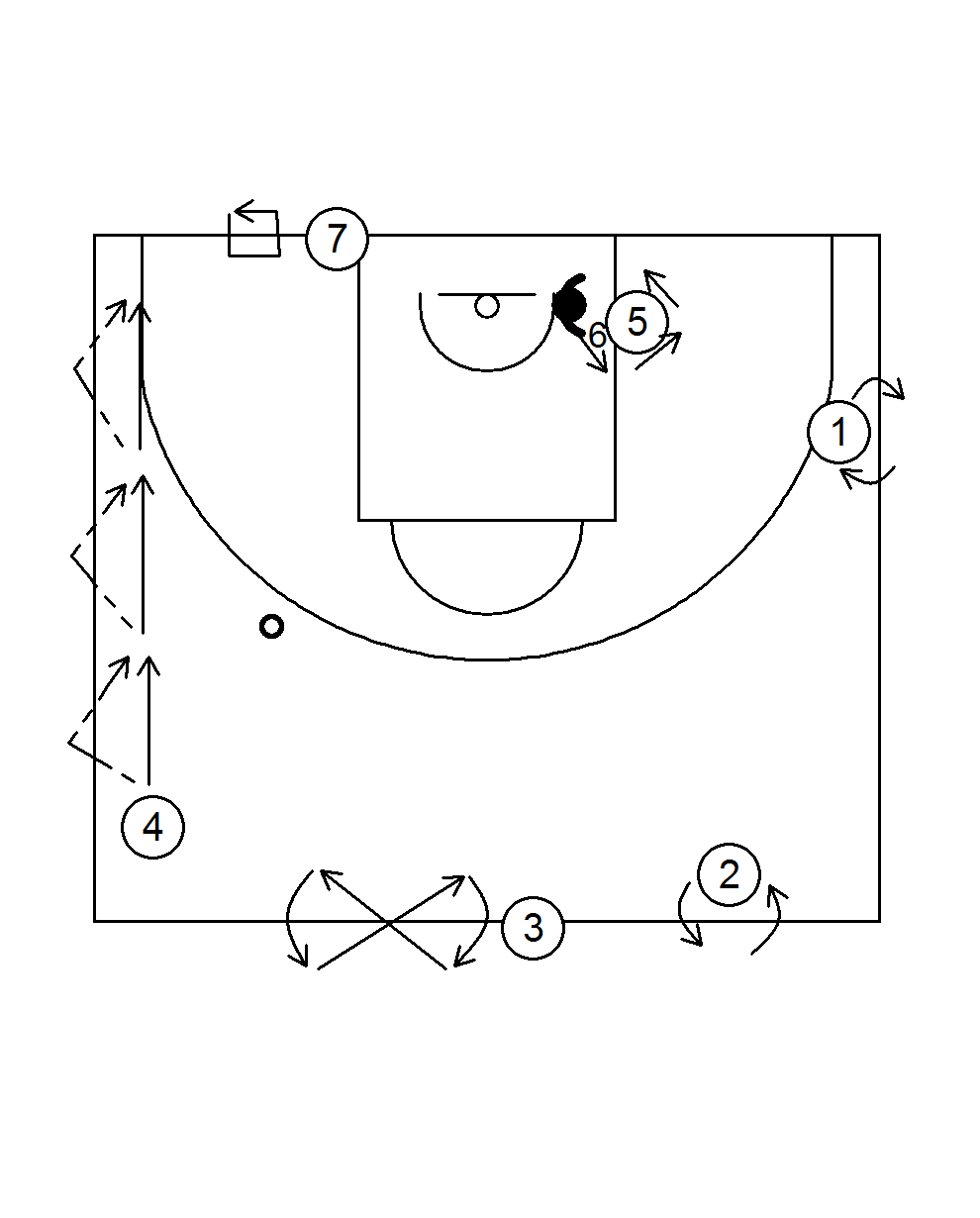
Requirements:
players must know what the correct defensive posture is have
Goal:
- reinforce good habits regarding defensive position
- To increase speed and flexibility of footwork
Organisation:
- do as circuit, 1 minute each time
- player 1 jumps sideways with 2 feet left and right of the line
- player 2 does that forwards and backwards.
- players jump with 2 feet forward wide - narrow - wide. With a jump in the air they do a 180 degree jump and start over again.
- player 4 passes the ball through the wall to himself and goes with slides to the position where he catches it again. Makes it more and more difficult for himself by increasing the distance.
- player 5 defends the mid post and chooses every time another position (behind, swim over - full front - swim over low and back again)
- player 7 makes a square with jumps on 1 foot (feather by landing) always 2x with right, then 2x with left. First left, then right etc.
Teaching points:
- knees bent
- head above the
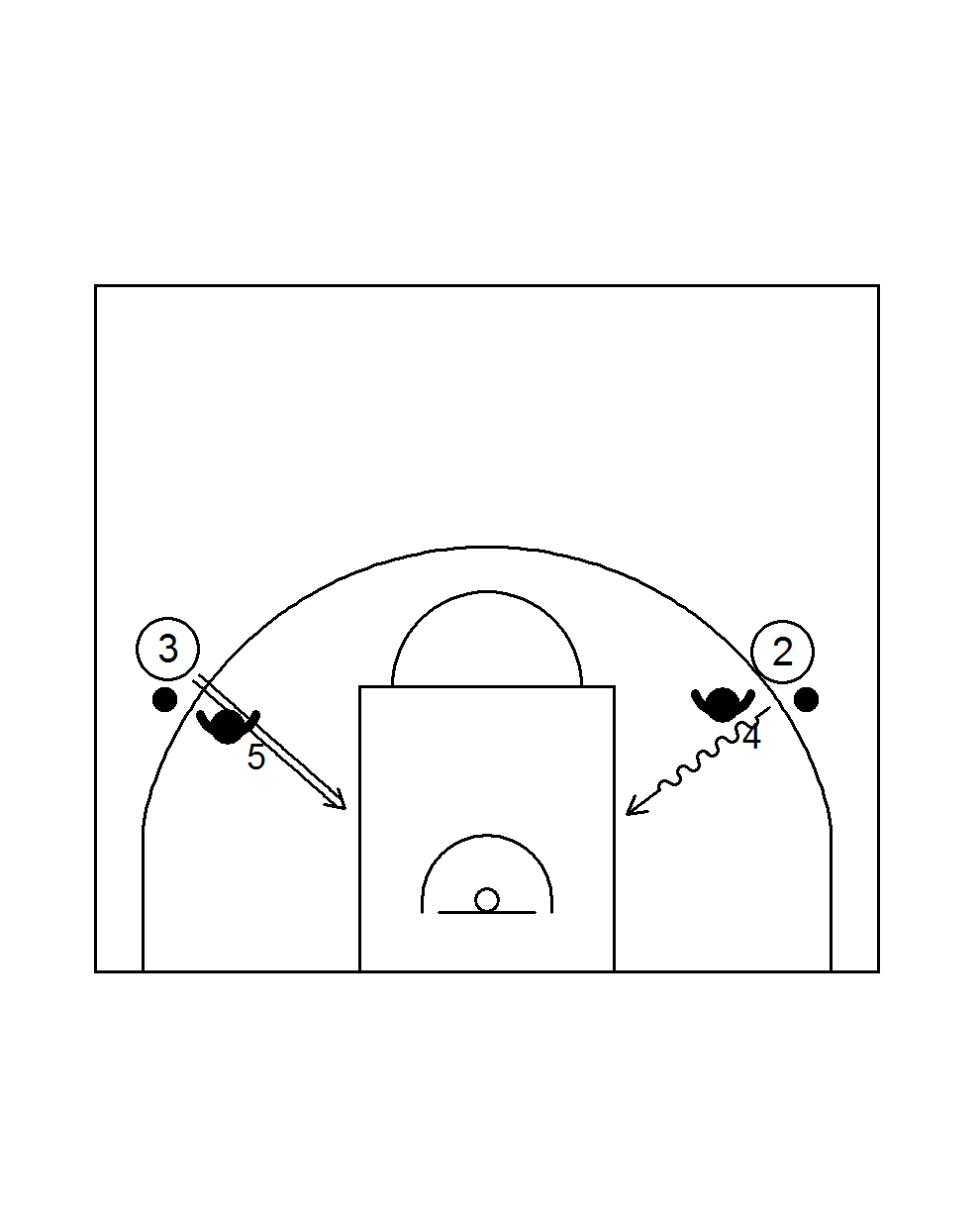
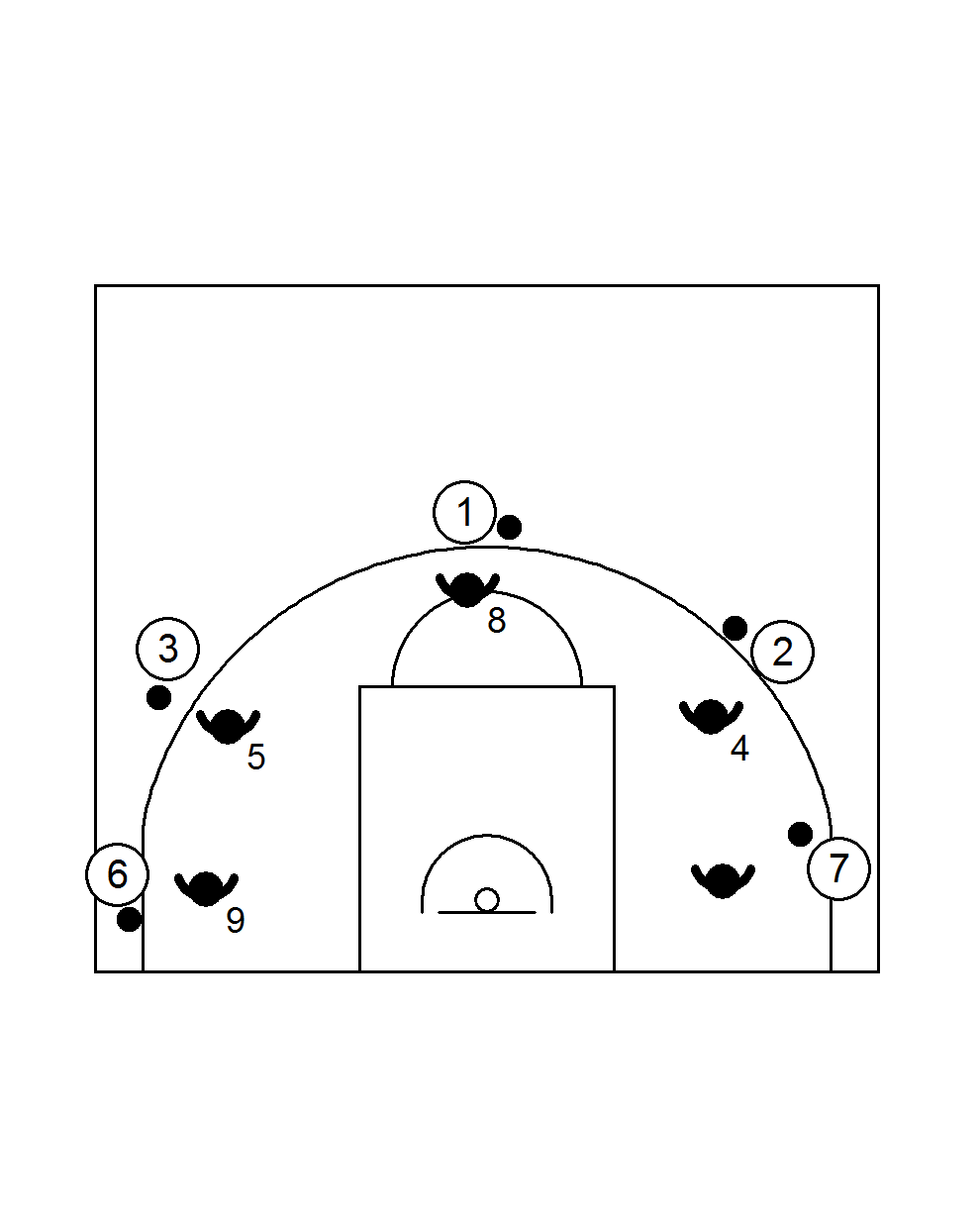
Goal: Defending the forward in triple threat position
Organization:
- attacker makes an agreed number of different feints before shooting or dribbling to the basket
- defender must anticipate with a drop step when the attacker threatens to go over the front foot
- with a two-footed backward hop when the attacker threatens to go over the back foot
- when the attacker brings up the ball, the defender should quickly step towards the attacker, stand against him, feet wider than the attacker,
- Trace the ball with your hands
- When the attacker brings the ball back down, the defender returns to his/her original position with a slide step or a hop backwards (arm's length distance)
Teaching points:
- react quickly on the feet, before the attacker does
- Distance from the attacker: match the threat he poses.
- Shorten the distance to the attacker with mini-slides, so that you can react immediately
Variations:
attacker gives a pass to himself from the bucket edge
Starting exercise:
- defender starts at arm's length
- Square up = feet next to each other, chest perpendicular to the line of the ball-basket when the attacker is standing on the axis of the field.
- Left foot forward when the attacker is standing on the right half of the field and vice versa.
- Attacker fakes the shot
- Defender steps forward, hand on ball
- Attacker brings the ball down
- defender recovers arm-length distance
- attacker makes max 2 dribbles, left or right
- after the stop, the defender steps forward again, hand on the ball
Form of play:
- as above, but with shot + boxing out (= wall and rebound)
- 2 scores in a row (also from the rebound!!) OR 2 stops in a row = loser presses and change
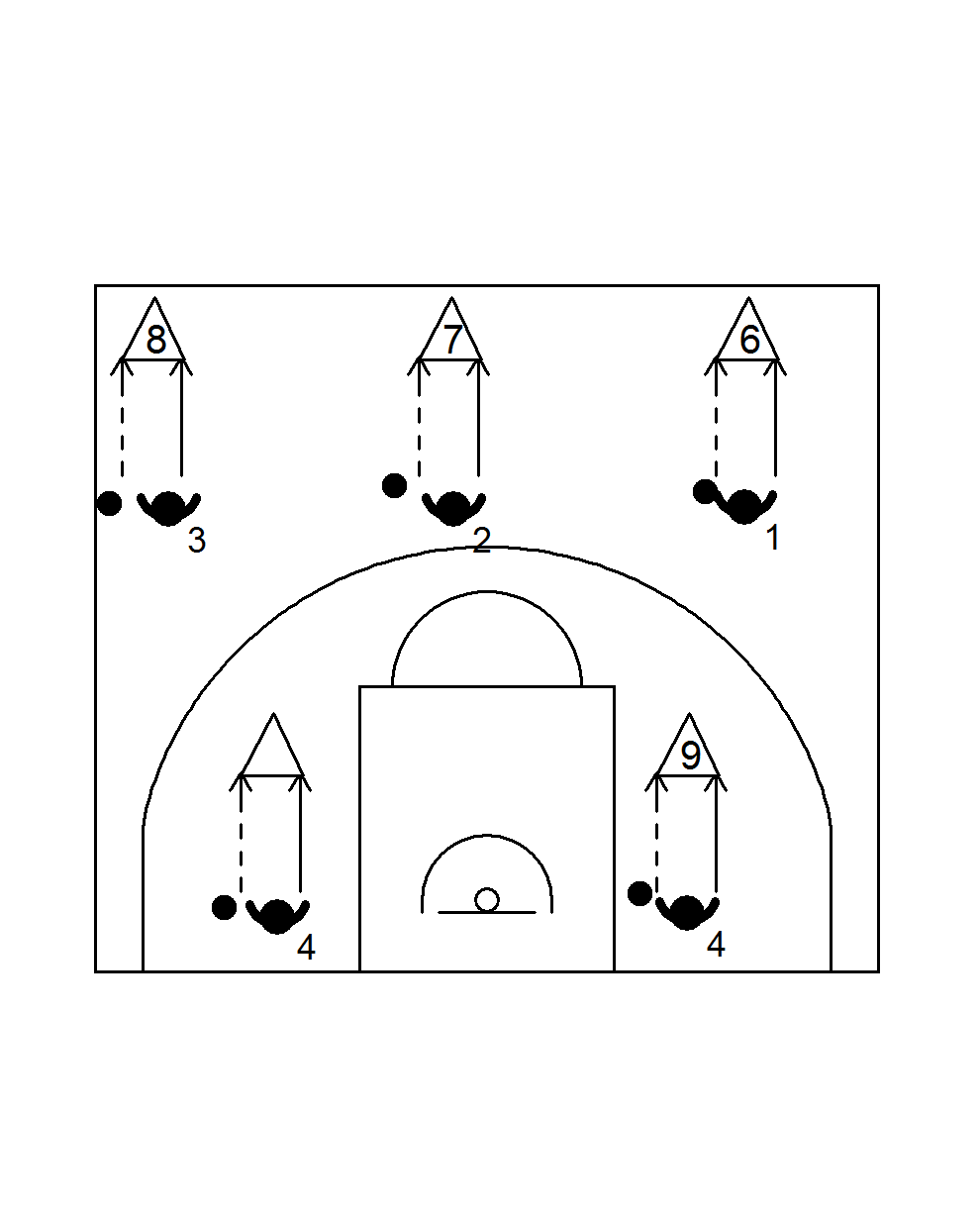
Goal: defend the dribbler after stopping the dribble
Organization:
- man with ball passes to opponent when trainer whistles
- who takes 1 bounce and stops the dribble in 2 Count Rhythm (2TR)
- The trainer counts down 5 seconds and then blows his whistle as end signal
- The aggressive defender steps back to his starting position
- The roles are now reversed
- As soon as the trainer whistles you pass the ball to the other player
- go for it aggressively straight away
- Try to prevent the other player from passing by keeping your hand in front of the ball (trace the ball)
- Try to get your feet to the left and right of the pivot foot of the man with the ball so that he cannot turn
Teaching Points:
- avoid mistakes; do not hit the ball
- Go for the 5 seconds
- Get as close as possible to the attacker (but stay in your own cylinder)
- Move your feet closer to the attacker, but keep your position between the attacker and the basket.
Variations:
- a third man to whom the ball must be passed within 5 seconds. Choose a limited area in which the third man can run free (use lines on the court, or place pawns).
- Pass from under the board to the player on the block. This player must try to pivot past the defender and score. Winner becomes attacker on the block, loser passes from the back line.
Form of play:
- Ten ball on the half court, where the receiver of the ball has to make a dribble start with 1 bounce before he can pass the ball on.
- idem, but defence MUST double team the man with the ball.
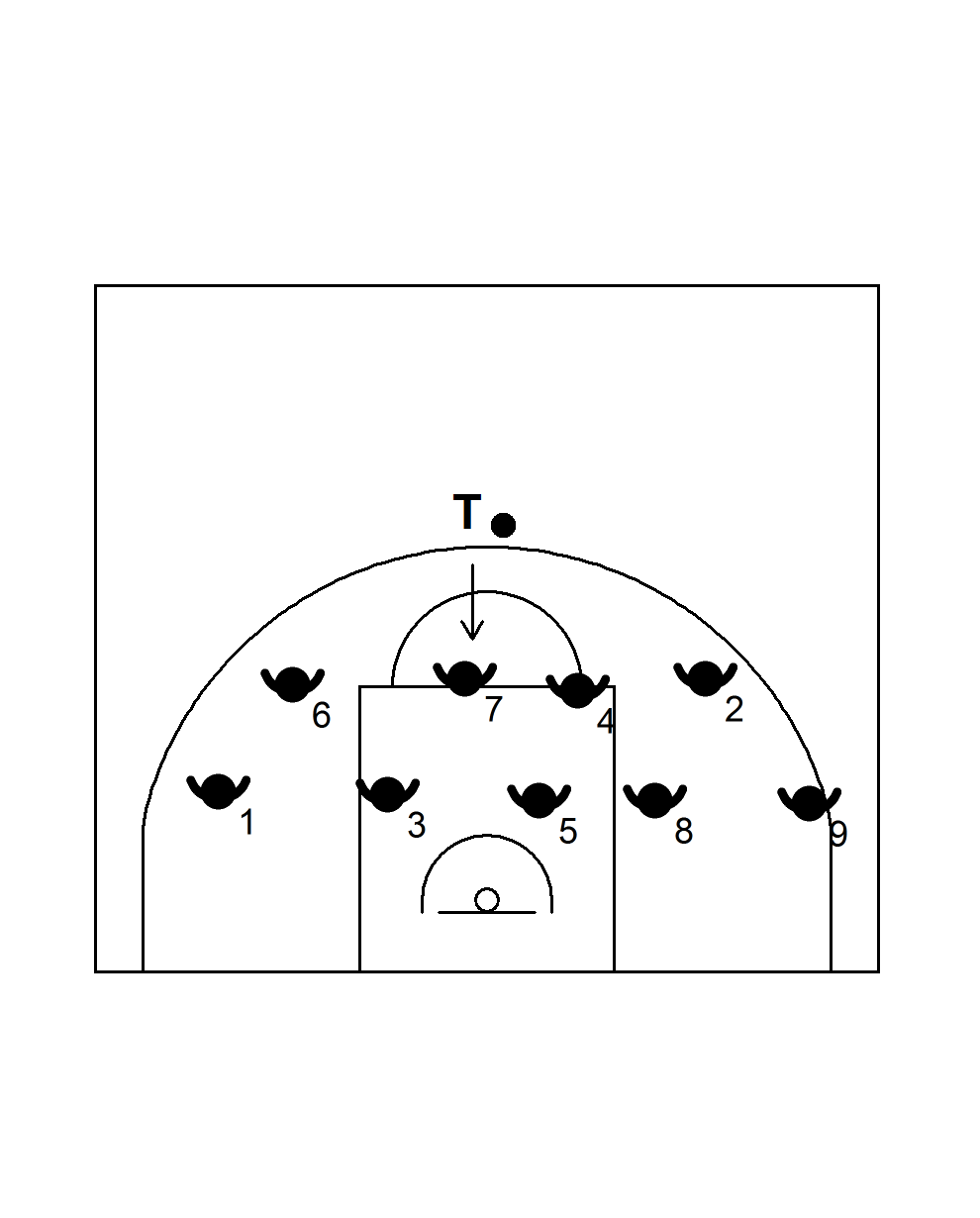
Goal: teach defenders how to catch the attacking foul (= penetrate or charge) (and how to handle physical contact)
Principles:
- when the attacker gets closer, move your feet further apart and lower your butt
- Hard forearm across your navel for protection.
- Always land on both buttocks.
- Land in the direction of penetration.
- roll to your shoulders and bring your legs up for protection
- DO NOT catch with your hands to avoid broken wrists.
- scream while falling
Preparatory exercises:
- players line up in defensive stance
- Trainer walks forward
- players put their feet outward, bring the hard forearm in front of their navel and lower their buttocks
- Trainer shouts "charge".
- players fall and roll on
defend the dribbler
- the trainer makes a zigzag movement
- the players make slide steps and drop steps as if they were defending the dribbler
- as the dribbler approaches, players move their feet outward, bring the hard forearm in front of their belly button and lower their buttocks
- trainer calls 'charge
- players fall on both buttocks in the direction of the penetration and roll through
spin dribble
- the trainer simulates a spin dribble
- players take two quick slide steps around their imaginary attacker, land wide, bring the hard forearm in front of their navel and lower their buttocks
- Trainer calls 'charge'.
- players fall on both buttocks in the direction of penetration and roll through








